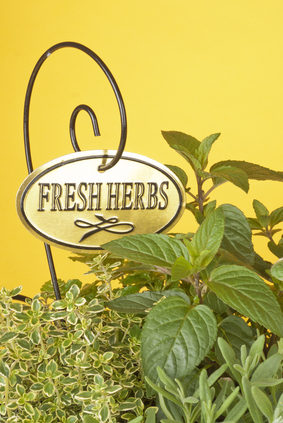
Fresh herbs are one of the most expensive items you can purchase at the grocery store. And what’s more, you have to buy them in bunches. But what if you just need a dash of rosemary or a sprig of thyme? Rather than buy overpriced herbs that might rot away in your refrigerator – unless you take the time to dry them – consider starting an herb container garden. You’ll have fresh herbs at your fingertips every time you cook. Here are a few tips to help you get started.
Choose a Sunny Location
Your herbs will grow more leaves if you put your container herb garden in a sunny location with some late afternoon and early evening shade. Herb gardens are best kept near a water source and as close to your house as possible. By putting your herbs in a convenient space, they will be easier to care for and to collect. Placing a long, rectangular potting container along your window sill will give you even easier access to your herbs.
Large Pots and Good Drainage
For people who love to cook regularly with their fresh, garden herbs, consider using large pots with good drainage instead of dealing with a bunch of small pots with one plant each. A 12 inch pot, for example, can hold about three to four plants. Be sure to check the bottom for adequate drainage holes.
Plant Herbs That Like Similar Conditions
Next, you’ll want to plant herbs that enjoy similar conditions. For example, if your palate prefers the spices of the Mediterranean, you can plant Thyme, Sage, and Rosemary together. Oregano, Lavender, and Marjoram are also a good mix. All of these plants like lots of sunlight and soil that’s on the drier side.
Use Top Notch Potting Mix
Grab a bag of potting mix, also known as growing medium, instead of potting soil. Container herbs grow best in potting mix because of its sterility and its ability to simultaneously retain moisture and aerate. You’ll have to add your own fertilizer to the potting mix and look for potting mix that contains some or all of the following.
* sand
* fine pine bark
* peat moss
* vermiculite
* perlite
Use Just Enough Water
It’s important not to use too much water or not enough water in your herb container garden. If you use too much water, you can cause fungus growth, pest problems such as gnats and root rot. On the other hand, too little water can cause your herbs to wilt. Wilting can stunt or even kill a plant.
You should only water your herb container garden when needed. To determine this, stick a finger into the plants’ potting mix, about 2 to 3 inches down. If it feels wet, don’t water. If it feels dry, water. Also keep in mind that young, small plants require less water than their mature counterparts.
Herb container gardening is a rewarding and economically smart way to add fresh, healthy herbs to your favorite favorite recipes. By following these tips and starting your herb garden today, you’ll add a touch of healthy living to your life.[ois skin=”below post”]


I have read all your blog posts over the last couple of days. One thing I seem to have missed. In fall 2012 you were filling your boxes with leaves, manure and compost and leaving them to winter over. In the spring you have a great already amended bed. Also, this was your method of finishing the manure and composting the leaves. Now, since you gardened through the winter or 2013/14, how did you change your spring bed preparation?
I did it the same way. The only difference was that I didn’t let it percolate during the winter months As you’ve seen, in the past I didn’t even cover the gardens. This past year I did with a make-shift hoophouse. I also planted my main 2 beds(which get the most winter sun)with all the winter crops I’ve mentioned so that they would be ready to eat for the entire winter. The other major change was that I did not add horse manure. I did add leaves though. I learned a lot of things the past 2 winters which I’ll be sharing over time.
When I emptied a square in the winter, I added my finished compost which I kept under cover in the hoophouse. I then let that square sit for just a couple of weeks until I started my spring garden-full fledge-on Presidents Day weekend. I think next year I’ll start it on March 1st. It takes so long to get going in February it seems. If I start in on the 1st of March it’s almost like it’s as good as if I planted in February….lots to figure out.